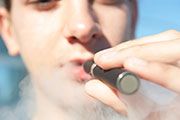AHA Takes Tough Stance on E-Cigarettes
The nation's youth, and its smoke-free air need federal protection from vapors from e-cigarettes, according to a set of recommendations released Aug. 25 by the American and Heart Association.

The nation’s youth, and its smoke-free air need federal protection from vapors from e-cigarettes, according to a set of recommendations released Aug. 25 by the American and Heart Association. Calling on the FDA to enact strict rules limiting the use and marketing of the devices—and echoing the text of a letter it sent the agency earlier this month--the AHA also wants the agency to ban sales to minors and bar manufacturers from using flavorings in making e-cigarettes.
“Vaping” as e-cigarette use is called, should be as tightly restricted as smoking, the AHA said.
The FDA has asserted its right to regulate the devices but has not yet released the rules it will use.
The device industry has promoted e-cigarettes as a tool to be used to stop smoking. But in findings published online in the AHA journal Circulation, the group cited its fears that the devices could do the opposite. “There are concerns that e-cigarette use could renormalize smoking behavior, sustain dual use [of e-cigarettes and tobacco products], and initiate or maintain nicotine addiction.”
Without strict regulation, the growing use of e-cigarettes could “erode gains in smoking cessation and smoke-free laws, according to Aruni Bhatnagar, PhD, the lead author of the AHA policy statement published in Circulation.
If adopted by the FDA, the AHA’s proposed restrictions could threaten a growing multi-billion dollar e-cigarette market, one entered by both independent manufacturers and global tobacco
companies. Their sale is banned in seven countries, including Canada.
The AHA policy asserts that decades of tobacco control efforts including FDA regulation, spending on quit-smoking programs, and getting health insurers to cover tobacco use cessation could go up in smoke if the spread of e-cigarette use is not restrained. The gains at risk include a 50% reduction in the youth smoking rate from 1997 to 2007, and an estimate 8 million lives saved
over the past 50 years. The current annual U.S. cost of smoking is $289 billion in direct medical care and other costs, the AHA says.
“We are fiercely committed to preventing the tobacco industry from addicting another generation of smokers,” said Nancy Brown, CEO of the organization in a news release.
In the Circulation article, the authors summarize the 11-year history of the devices and catalogue their various designs. Citing difficulties in getting accurate information about who uses e-cigarettes, the article notes that most customers are current or former smokers but “overall use patterns are unclear and constantly changing.”
They also report that by 2012, 1.78 million high school and middle school students nationwide had tried e-cigarettes, noting that “adolescents do consider e-cigarettes as high-tech, accessible, and convenient, especially in places where smoking cigarettes is not allowed.” These young users are also likely to be influenced by marketing featuring celebrities and appealing flavors like chocolate and strawberry, the authors wrote.
So far the advertising of e-cigarettes has escaped the restrictions faced by tobacco products.
Though there is widespread perception that e-cigarettes are less toxic than tobacco, they deliver nicotine, and have been known to cause accidental poisoning, according to the AHA. Some byproducts of the devices’ vapors may be carcinogenic, including propylene oxide, which is generated when the aerosol used to resemble cigarette smoke breaks down.
The AHA cited other concerns about the long-term effects of e-cigarette use and called for more surveillance of their potential public health impact—including fetal development and possible environmental effects.